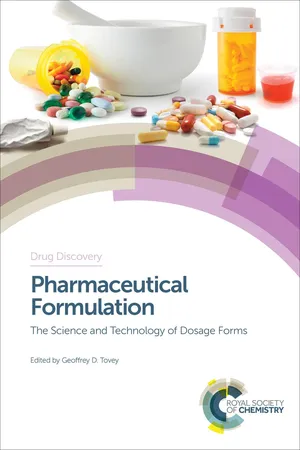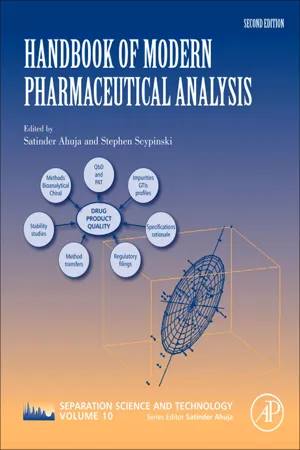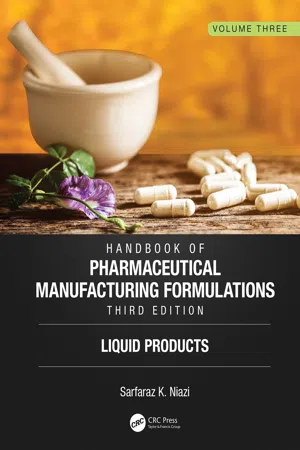Chemistry
Formulations
Formulations in chemistry refer to the specific composition and arrangement of ingredients in a chemical product. This includes the precise proportions of each component and the methods used to combine them. Formulations are crucial for creating products with desired properties and functions, such as pharmaceuticals, cosmetics, and industrial chemicals.
Written by Perlego with AI-assistance
Related key terms
Related key terms
1 of 4
Related key terms
1 of 3
3 Key excerpts on "Formulations"
- eBook - ePub
Pharmaceutical Formulation
The Science and Technology of Dosage Forms
- Geoffrey D Tovey, Geoffrey D Tovey(Authors)
- 2018(Publication Date)
- Royal Society of Chemistry(Publisher)
6“Formulation”, or “to formulate” a compound, is the process of preparing a drug product from the drug substance (the active pharmaceutical molecule), making it suitable for use in clinical therapy. For small molecules which are generally delivered by the oral route the term “active pharmaceutical ingredient” (API) is often used. In traditional small-molecule pharmaceutical development, APIs are mixed with other chemical compounds, excipients, to produce a dosage form that is clinically suitable for the intended therapy (e.g. tablet, injection or cream). As well as ensuring that the small-molecule API is capable of being delivered in an active form to the patient, the formulation must also ensure that the small molecule is stable during the shelf-life of the product. The addition of the excipients must be determined to have a stabilizing effect on the API.Some activities that have to be performed in the formulation of biopharmaceuticals are also required for small molecules, but many are quite different. One analogy7 with our day to day experience with food is to compare the stability and “formulation” of small chemicals like salt and sugar (or aspirin and paracetamol) with the stability of dairy products such as eggs, yogurt or ice cream, dried fruits and meat, each of which poses a challenge in stabilizing their proteins in a “fresh” state.11.2 Formulation of Small Molecules vs. Biopharmaceutics
Whereas small-molecule drugs have molecular weights below 1 kDa, proteins are much larger, for example, the molecular weight of human calcitonin is 3.4 kDa, hirudin is 6.9 kDa, human growth hormone 22 kDa, antibodies 150 kDa, and Factor VIII about 260 kDa. The proteins consist of polypeptide chains of amino acids (the primary structure), which may be in some cases glycosylated. The polypeptide chains adopt well-defined three-dimensional structures (the secondary structure). The tertiary structure refers to the structures of complex proteins that have more polypeptide chains covalently linked, each peptide chain having its own secondary structure. An additional layer of complexity that can arise in proteins is the “quaternary structure” which is formed by the association of independent tertiary structural units via - eBook - ePub
- Satinder Ahuja, Stephen Scypinski(Authors)
- 2010(Publication Date)
- Academic Press(Publisher)
The transition from discovering a new therapeutic agent to developing a new pharmaceutical product begins with an investigation of the physical and chemical properties of the active pharmaceutical ingredient (API), a process commonly referred to as “preformulation.” This is a key milestone in the drug development process, as the focus shifts from looking at the therapeutic agent as a molecular entity to how it can be effectively made into a product. Preformulation studies, when effectively conducted, can be accurate predictors of the challenges that will be encountered in combining the API with a suitable system that will deliver this new therapeutic agent in a safe and effective manner to a patient. Following preformulation, formulation development activities will begin, with the primary goal of developing a robust bioavailable, efficacious, and safe dosage form that can be manufactured at a suitable scale for commercialization.This chapter will discuss the role of the analytical chemist in the preformulation process and highlight the methods that will need to be developed, validated and utilized to support these studies. An assortment of analytical techniques is needed to measure a number of critical quality attributes of the new molecular entity such as solubility, purity, and crystalline habit. The methods will be used to make important decisions such as the choice of salt form, or which solid oral dosage form has the best probability of providing adequate exposure in an early phase clinical study. These analytical tools are critical to the decision that a pharmaceutical development organization uses to evaluate the first round of solid dosage form development prior to the availability of clinical data.The pharmaceutical analytical chemist is a key collaborator with the formulation development scientist who is charged with generating and providing the information about the dosage form(s) under study which will guide the formulation scientist in his/her quest to transform a chemical entity into a medical product.One key distinction that needs to be made is the difference between information (or knowledge) and data. Data are a collection of numbers and/or values, for example, an assay value generated by high-performance liquid chromatography (HPLC). The individual datum may be accurate and correct, but in and of itself it provides little value. It may be evaluated against a predetermined acceptance criterion, to serve as a release mechanism for a test article, but it does not, by itself provide analytical information about the drug product. Only when that individual datum is placed into the correct context does it allow for the generation of knowledge about the behavior or attributes of the product. One example of this approach is to compare this individual datum to other data points collected under different conditions, such as that done during the performance of a stability study. Now the individual datum is placed in a context of time under a fixed storage condition (such as the stress condition of 40 °C/75%RH). When compared with other assay values at different times under a constant storage condition, a trend analysis can be performed. For example, one can apply such a strategy to potency and see if this critical attribute changes with time. This trend can then be extrapolated to later time points to predict where the potency value will be at a future time which is a key attribute in determining the shelf life of a product. The data, placed in the correct context, will generate useful information which will allow for informed decisions and potential prediction of future outcomes. Further context can be added such as the formulation of the drug product and additional sets of data generated from different Formulations so that, for example, the stability of one formulation relative to another can be derived from these assay value(s). The reader is referred to Chapter 12 - eBook - ePub
Handbook of Pharmaceutical Manufacturing Formulations, Third Edition
Volume Three, Liquid Products
- Sarfaraz K. Niazi(Author)
- 2019(Publication Date)
- CRC Press(Publisher)
5 Formulation Considerations of Liquid ProductsLiquid Formulations offer many advantages, from ease in dosing to ease in administration (easy to swallow), and myriad possibilities of innovative drug delivery systems. One of the most desirable features of liquid Formulations, particularly the solution forms, is the relatively lower importance of bioavailability considerations, as the drug molecules are already in the dispersed phase, removing many rate-limiting steps in the absorption of drugs. For the purpose of this volume, liquid Formulations include Formulations that have liquid characteristics, meaning that they can flow, and thus, include clear liquids, suspensions, and extemporaneous powder suspensions (which could easily be classified as uncompressed solids but for the stability considerations post reconstitution, which are common to liquid preparations). However, all the advantages of liquid dosage forms are balanced by the many problems in their formulation. These include stability problems, taste masking needs, phase separations, and so forth, all of which require highly specialized formulation techniques.I. Solubility
The amount of active drug dissolved per unit of a solvent or liquid base is a critical parameter subject to many factors, including temperature, presence of electrolytes (salting-out effect), complexation with other components, state of crystallinity (such as amorphous), nature of crystals (inclusion or imperfections), hydration, solvation, and so forth. One of the most important studies conducted on new chemical entities is the study of solubility characteristics, phase conversion, and saturation limits under different conditions. Where the amount of drug is above saturation solubility, an equilibrium is established between the solution (monomolecular dispersion) and undissolved particles (often multimolecular dispersions), the direction and extent of which are governed by many physicochemical factors. Because the absorption of drugs takes place only from a monomolecular dispersion (except in such instances as pinocytosis, etc.), the equilibrium between the two states is critical to drug absorption. A large number of pH-adjusting buffers are used in liquid products to modify the solubility of drugs as well as to provide the optimal pH for drug absorption and drug stability. The dielectric constant of the solvent (or composite dispersion phase) is important in determining the solubility. With available values of dielectric constant, for both pure systems and binary systems, it is easy to project the solubility characteristics of many new drugs. Another factor determining the solubility of drugs is the degree of solubilization in the dispersion phase.
Index pages curate the most relevant extracts from our library of academic textbooks. They’ve been created using an in-house natural language model (NLM), each adding context and meaning to key research topics.
Explore more topic indexes
Explore more topic indexes
1 of 6
Explore more topic indexes
1 of 4


